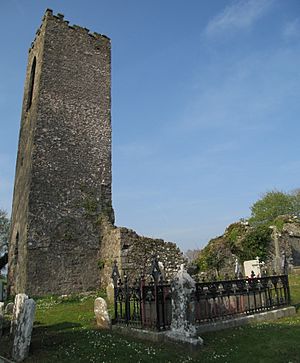Richard Clayton (Irish judge) facts for kids
Richard Clayton (1702–1770) was an important judge and politician from England who worked in Ireland during the 1700s. He held a high position as the Chief Justice of the Irish Common Pleas. However, his career was greatly affected by a very unfair trial and punishment of a man named Father Nicholas Sheehy. This case is remembered as a major example of when justice went wrong.
Early Life and Career
Richard Clayton was born in 1702. He was the second son of Richard Clayton, who owned a large estate called Adlington Manor in Lancashire, England. His mother was Martha Horton.
Richard Clayton studied law at the Inner Temple in 1724. He became a lawyer in 1729 and later became a King's Counsel in 1768. He inherited Adlington Hall and its lands in Lancashire.
He was also involved in politics. He served in the British Parliament as a representative for the town of Wigan. He also worked as a judge for Wigan. One of his most well-known cases as a lawyer was defending Francis Towneley. Even though Towneley was found guilty, it didn't mean Clayton was a bad lawyer, as the evidence against Towneley was very strong.
In 1765, Richard Clayton moved to Ireland to become the Chief Justice of the Common Pleas. He served in this important role until 1770. He had to leave his job because he became ill. He returned to Adlington, where he passed away later that same year. He was buried in Standish Church. Richard Clayton never married. His nephew, also named Richard, inherited his estate and later became a baronet.
The Father Sheehy Trial
Richard Clayton is mostly remembered for leading the trial of Father Nicholas Sheehy. Father Sheehy was a parish priest from Clogheen, County Tipperary. The trial happened in March 1766 in Clonmel. It became famous in Ireland as a symbol of unfairness.
Father Sheehy was known for speaking out against the Penal Laws. These laws were very strict rules that limited the rights of Irish Catholics. Father Sheehy had been tried before for other reasons, but those trials were not successful.
During his trial, many people believed the witnesses who spoke against Father Sheehy were not telling the truth. It was even unclear if the person Father Sheehy was accused of harming was actually gone, as no body was ever found. Father Sheehy also had a strong alibi, meaning he could prove he was somewhere else when the event was said to have happened.
Despite the weak evidence, Father Sheehy was found guilty. He faced a severe punishment on March 15. Clayton also oversaw the trial of Father Sheehy's cousin, Edmund. Edmund was also found guilty and faced a severe punishment. Even though Edmund himself said Clayton had acted fairly in his case, many people still criticized how the trial was handled.
His Reputation
Many historians in Ireland have strongly criticized Richard Clayton for how he handled the Father Sheehy case. They don't think he was trying to be dishonest, but rather that he might have been new to Irish politics and a bit naive.
However, there is also evidence that in other cases, Clayton acted fairly and kindly. A later important judge in Ireland, the Earl of Clare, remembered Richard Clayton as a good and honest judge.


